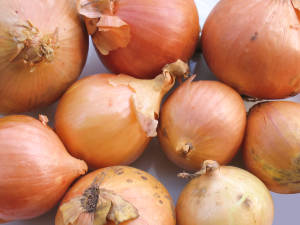Onions are a frequently used vegetable in cooking around the world. Most often they are used as an ingredient in cooking, in a salad or pickled. Due to their frequency of use, many people want to learn how to grow onions.
Onion Varieties
Onions are generally classified according to their color. The most common variety is the bulb onion, which comes in red, brown or white/yellow varieties. There are also green/spring onions, which are long and slim rather than round and bulbous. Sometimes these onions are called ‘scallions’, particularly in the U.S. or incorrectly called shallots. Spring onions are simply young onions that have not yet made a bulb that are grown for the green shoots they produce.
Choosing a Type of Onion to Grow
Selecting a type of onion to grow will largely depend on how much daylight is available in your area of the world. 15 hours in summer is enough daylight to grow just about any type of onion.
Talk to your local nursery for advice on choosing the right onion for your area and time of year.

Where To Grow Onions
Onions require a large, sunny patch of earth with rich soil and good drainage. They are best suited to cooler climates and are therefore recognized as a ‘winter’ vegetable. Tropical and subtropical climates are difficult or impossible to grow onions in.
It’s possible to grow a few onions in raised beds. It’s not a good idea to grow them in growbags.
Planting Onions
Dig a bed, using generic fertiliser, manure or compost a few weeks before planting onion seeds or sets. It’s a good idea to add a bit of lime to prevent fungal disease and to aid growth in acidic soils.
If planting from seeds, sow them about half an inch (1.5cm) deep in rows separated about 12 inches (30cm) apart. As they grow, gradually remove the weaker seedlings so that the onions gradually get more room to grow. At the end of the growing process your onions should be about 4 inches (10cm) apart.
If planting from sets, plant them 4 inches (10cm) apart in rows 12 inches (30cm) apart.
It’s difficult to give a plant time due to different regions/climates and onion varieties. Your local nursery will be able to help out with timings.
Growing Onions
Once the onions are planted, water is required if rain is scarce. There’s no need to over-water onions, just a bit of moisture is fine.
As they take a long time to grow it’s a good idea to use fertilizer once bulbs start to form. Keep weeds away as they will take over your growing area. Hand weed around the bulbs, and mulch to keep the rest of the weeds down. Mulching will also ensure the soil is moist.
Expect a growth time of 6 to 8 months.
Harvesting Onions
Onions can be harvested once the leaves begin to dry out. Simply lift them out of the soil and allow them to sit in the sun for a few days. If the weather is bad, lay them in doors and turn them every so often.
Store in a cool, dry place. Moisture and humidity leads to rotting. Using an onion rope is a particularly attractive way of storing onions.

Pests and Diseases
In the early stages of growing, birds are the biggest threat to your onions.
Onions thrips are tiny bugs that can take up residence around the base of the leaves. Thrips can be killed with a pesticide, but if you prefer to be pesticide-free a well watered and large onion will usually survive a thrip or two.
Onion maggot most frequently occurs when organic fertilizer is used too soon before planting. It can be controlled by insecticide by spraying just after seedlings emerge and then again 10 days later.
Grey, fuzzy patches sometimes appear on leaves, which is called ‘onion downy mildew’. This disease thrives in humidity, so be careful not to overcrowd plants. Remove the leaves as soon as possible
The biggest pain that one can experience is ‘Onion white rot’, a fungal disease that is all but impossible to eradicate. If you see a cotton wool like growth on any of your onions, remove the onions from the crop immediately, as well as as much of the soil around them you can spare. Dispose of the soil and onions in the bin and not the compost. Be careful not to spread it to other parts of your garden via your footwear. Don’t plant any onions, leek or garlic in the same area for 10 years. There’s no chemical control for onion white rot.

